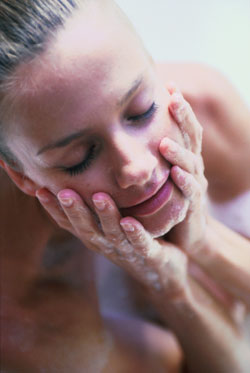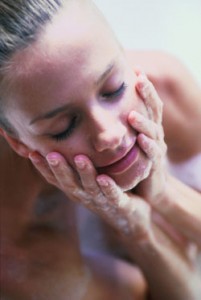Natural Selection

Natural Selection
The pursuit of beauty can be a kinder, gentler process—thanks to products made with
nutrients and botanicals. ET highlights the hottest natural ingredients to hit store shelves.
By Susan Weiner, Energy Times
We all know glowing skin and healthy hair when we see it. I remember the first time I saw it. A number of years ago, while traveling through Europe, I met an older woman—perhaps in her late 50s to early 60s—with flawless skin. Her face was youthful and lacked the tell-tale sun spots and deep lines typical of someone her age.
 I asked for some details of her beauty regimen and learned that she never used soap—she washed only with gentle cleansers or water, then applied oils and other botanicals. Inspired, I would only wash my face with plain water and moisturize with olive oil and aloe vera. Within a few weeks my skin cleared up and no longer had that taut feeling I’d get after washing with soap. Friends and strangers commented on how my skin glowed.
I asked for some details of her beauty regimen and learned that she never used soap—she washed only with gentle cleansers or water, then applied oils and other botanicals. Inspired, I would only wash my face with plain water and moisturize with olive oil and aloe vera. Within a few weeks my skin cleared up and no longer had that taut feeling I’d get after washing with soap. Friends and strangers commented on how my skin glowed.
While most women once relied on products solely made with harsh chemicals to achieve “natural beauty,” today more and more appear to be getting in on my little European secret. Olive oil and aloe vera happen to be two of the hottest natural ingredients in beauty products, providing results to back up the hype. Manufacturers have responded to this rising demand with more innovative products rich in vitamins, nutrients and naturally extracted oils. Here, Energy Times offers a rundown of the most powerful and pleasing natural ingredients and just how they can aid in your personal transformation.
“Ingredients that are all-natural are not going to do their job and leave—they stay and give you added benefits,” says Natalie Back, a New York state-licensed Paramedical Esthetician at August Moon Spa at La Tourelle Resort in Ithaca, New York (www.latourelle.com). “The more natural ingredients you can put on your skin, the better. They’re going to help you from both the inside and the outside.”
So here are the natural beauty ingredient all-stars.
Olive Oil
Commonly found in a range of personal products, olive oil is a basic kitchen staple with myriad cosmetic benefits. Used in soaps, shampoos, body lotions, lip balm, bath oils, massage oils, nail soaks and dandruff treatments, olive oil has protective, salutary effects for the entire body. Rich in antioxidants, which fight skin-cell damage caused by free radicals, quality olive oil can protect against aging by inhibiting oxidative stress, with both Japanese and German researchers claiming that virgin olive oil applied to the skin can protect against tumor growth and aging.
At Good Groceries in Watkins Glen, New York, co-owner Jylle Benson-Gauss maintains the same philosophy that, if it’s edible, it’s good for your skin. “In general, the rule is, don’t put anything on your skin that you wouldn’t eat,” says Benson-Gauss. “Your skin is like a giant sponge. Everything we put on our skin is absorbed.”
Tea Tree Oil
Long revered as an antiseptic by the Aborigines, the native people of Australia, and once used by British sea captain James Cook to improve the flavor of beer, tea tree oil contains terpenes, beneficial types of proteins which possess anti-infective properties that are effective against skin outbreaks and sundry fungi. The Chopra Center Herbal Handbook recommends that “every household should keep some tea tree oil close at hand. It can be applied directly to skin irritations.”
Esthetician Natalie Back is living proof that tea tree oil and other botanicals work wonders on troubled skin. “As a child, I had severe acne,” says Back. “My mother took me to see an esthetician, and we used a lot of cleansers with tea tree oil, in addition to pumpkin enzyme peels with aloe vera and an aloe vera toner. I also used a lavender and chamomile moisturizer.” Today, Back’s glowing skin is a testament to the benefits of natural beauty care.
Additional miseries tea tree can ameliorate include insect bites, sunburn and minor cuts and scrapes; its anti-fungal properties make it useful against athlete’s foot, jock itch, ringworm and many vaginal infections. Tea tree also makes a refreshing, odor-killing foot soak.
Vitamin C
Typically thought of as a supplement to take internally, vitamin C topical preparations can deliver even higher dosages of the skin-strengthening vitamin. This stimulates production of collagen, the connective tissue that keeps skin firm and taut. Lotions and serums enriched with vitamin C—a well-known antioxidant—may also help repair and minimize fine lines and wrinkles caused by sun exposure and aging, and protect the skin against environmental oxidative pollutants and other free radicals.
Vitamin C cream applied daily to healthy female volunteers with sun-damaged skin over a six-month period resulted in a significant decrease in lines and wrinkles, according to a study published in Experimental Dermatology. Skin biopsies revealed improved collagen structure and reappearance of elastic fibers in the vitamin C-treated skin, confirming the results of other studies demonstrating that the vitamin reverses cumulative skin damage from sun exposure.
For an at-home vitamin C treatment, Back recommends rubbing a slice of fresh orange in circular motions on the face before going to sleep, three nights a week. “The vitamin C in the orange will help with cellular renewal, naturally exfoliating hyperpigmentation scars,” says Back. “Your epidermis will look like a whole new skin.”
Green Tea
Just like vitamin C, green tea—another edible skin healer—is valued as a wrinkle-reverser, inhibiting inflammation and sun damage. An article published in the Archives of Dermatology concurs that green tea may, indeed, ward off skin cancer and signs of aging. Researchers at Case Western University in Cleveland maintain that the secret to green tea’s skin-protective properties are its high levels of polyphenols and catechins, powerful antioxidants shown to function as anti-inflammatory and anti-cancer agents.
“Of all the antioxidants known to mankind, the components of green tea are the most potent,” says Hasan Mukhtar, PhD, professor and director of research at Case Western University. Not quite as popular as its cousin black tea, green tea comes from the same Camellia sinensis plant, but its leaves are less processed.
Aloe Vera
Aloe vera and skincare products seem to go hand-in-hand; with more than 200 biologically active agents—including vitamins E, B and C and the mineral zinc—aloe vera possesses powerful anti-inflammatory, burn healing, and wound- and scar-healing properties. When used as part of a daily skin care regimen, aloe vera helps to keep skin supple by transporting oxygen to skin and removing dead cells.
Topically, aloe vera benefits dry and cracked skin, allergic reactions, burns, wounds, insect bites, blisters and even frostbite. Studies consistently demonstrate that aloe vera is effective in soothing a wide variety of skin ailments, including mild to moderate symptoms of psoriasis, eczema and seborrhea.
Shea Butter
Also known as karite butter, shea butter comes from the fruit of the shea nut tree, which grows wild throughout the arid regions of Central Africa. Processing shea butter involves sun-drying and roasting the nuts before extracting the creamy, rich, solid oil by hand.
“Shea butter, besides being a saturated fat, has all kinds of vitamins and compounds, including vitamin A, vitamin E, allantoin and catechins,” says Larry Plesent, founder of Vermont Soapworks and Green Products Alliance, a consortium of more than 100 manufacturers that pledge not to use hazardous ingredients. Plesent is a huge fan of shea butter, having spent significant time in Africa observing the production process: “Plants like the shea nut tree are chemical factories.”
Shea butter is used to soften skin and hair, heal wounds and scars, prevent stretch marks and soothe minor burns, muscle aches and rheumatism. Its non-greasy feel makes it a popular choice among massage therapists and spas. When shopping for shea butter products, Plesent recommends looking for the terms “raw,’’ “organic,’’ “traditional’’ or “unprocessed’’ on the label.
Lavender
Which common shrub can help heal insomnia, mood disturbances, depression and anxiety? The answer is lavender, a plant generally appreciated for its pretty purple-blue flowers and aromatic fragrance, and frequently used in soaps, shampoos and sachets. Widely available as aromatherapy oil, bath gels, infusions, extracts, lotions, soaps, teas and tinctures, lavender is a natural remedy for a range of ailments, with recent studies confirming years of anecdotal evidence showing that lavender produces soothing, calming and sedative effects.
Lavender oil is used to treat skin ailments such as fungal infections, wounds, eczema and acne. This fragrant herb is also used in inhalation therapy to subdue headaches, nervous disorders and exhaustion, and to induce deep sleep.
Chamomile
Similar in its benefits as lavender, creams and sprays with chamomile are used to calm nerves and nourish the skin. Revered by the pharaoh’s healers and depended upon by the Greeks for a variety of medicinal purposes, chamomile (Matricaria recutita) is still used to heal abscesses, bruises and sunburn, and is included as an ingredient in many massage oils.
Exhibiting an odor similar to apples, chamomile is well-known for soothing and rejuvenating the spirit. However, it has not been easy for scientists to explain just how chamomile works, since the herb contains so many different natural chemicals. The essential oil likely interacts with the brain, stimulating healing systems within the body.
By tracing established, all-natural healing remedies back in time, and by incorporating these beneficial ingredients into wholesome products today, each of us has the opportunity to maintain skin that looks its best at any age, on any day of the week. Isn’t it about time to be a true natural beauty?